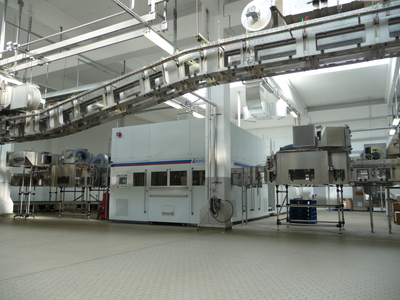
Die neue Maschinengeneration InnoPET Plasmax 20Q ist bei Eckes-Granini in eine aseptische KHS-Linie integriert und beschichtet 1-l-PET-Flaschen für Fruchtsäfte und Nektare mit einer hauchdünnen Barriereschicht aus Glas.
High-capacity KHS InnoPET Plasmax 20Q in operation
Eckes-Granini, one of the leading manufacturers on the European fruit juice market, is now also relying on KHS Plasmax barrier coating technology for its PET bottles at the Bröl plant in North Rhine-Westphalia. The InnoPET Plasmax 20Q in operation here is a new development with regard to the size of the machine in that it has a considerably higher capacity than the InnoPET 12D on the market to date and is able to barrier coat up to 40,000 bottles an hour. At Eckes-Granini the InnoPET Plasmax 20Q has been integrated into an aseptic KHS filling line where it barrier coats 1-liter PET bottles holding fruit juices and nectars. By opting for the InnoPET Plasmax 20Q, Eckes-Granini once again emphasizes the pioneering position it occupies in the filling of fruit beverages in PET in Germany. Granini fruit spritzers, for example, have been on sale here in various flavors, filled in 1-liter PET bottles, since the year 2000. One of the reasons for again choosing KHS Plasmax technology was that the bottling plant had had very good experience with the smaller InnoPET Plasmax 12D machine at its facility in Switzerland. Bernhard Hinken, plant manager at Eckes-Granini in Bröl, says, "For us, several years of working with KHS technology in Switzerland has proved that PET bottles barrier coated by the Plasmax system reliably ensure the highest quality of our products." PET bottles that have an InnoPET Plasmax barrier coating also provide particularly sensitive food and beverages with the best possible protection against loss of quality caused by gas transfer with the surrounding atmosphere. This tasteless, crystal-clear coating combines the advantages of both glass and PET in one packaging system. The InnoPET Plasmax barrier coating process involves applying a wafer-thin layer of silicon oxide or pure glass to the inside of the PET bottle to reliably prevent the exchange of carbon dioxide, oxygen, water, flavorings, and colorings, for example, between the product on the one hand and the packaging and environment on the other. One advantage of the InnoPET Plasmax process that is highly regarded on the market as opposed to all other barrier technologies currently available is that the glass-coated PET bottles are totally suitable for use in established recycling processes. With its high output, KHS' InnoPET Plasmax 20Q is also setting new standards when it comes to reducing costs specifically earmarked for barrier coating. Both points make the KHS InnoPET Plasmax system an even more interesting prospect with regard to the bottling of beer and highly productive bottle manufacture by converters, particularly on the North American market.
